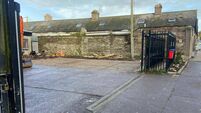Rewards could be plentiful for Sinn Féin if the IRA follows through
If it proves to be the case that the IRA has actually given up training, recruiting, intelligence gathering and all the associated activities of a paramilitary campaign, and if the IRA decommissions all of its weapons, then we will truly be in a significantly different place. If the IRA can also stand down its associated criminal activity and disown and assist in bringing to justice those involved in criminal activity then its achievement will be more than impressive.
The jury of public opinion is still out on the promises made in last week’s statement. Much of the verdict on whether the IRA actions will be as good as its word will be determined by the de Chastelain decommissioning body and the two reports of the Independent Monitoring Commission.
If it comes to pass, the lives of both communities in Northern Ireland will be changed, and that will be the most significant prize. Although they have enjoyed relative peace, and dramatically less violence in the past decade or so, the peace has and will always be uneasy until the IRA has definitively gone away.
One other thing is certain: there are substantial political prizes available to Sinn Féin, north and south, if the IRA follows through.
If the verification period between now and next spring goes well, then the peace process will be over and Northern Ireland’s political parties will be negotiating the terms of entry into government, and settling down to exercise real executive power, perhaps even including responsibility for justice and policing.
In the Republic, a Sinn Féin disentangled from the web of IRA paramilitarism and criminality will grow, and grow dramatically. Although Sinn Féin is and has been, for the past decade, on a fast growth trajectory in the Republic, its capacity for electoral advancement here was always going to be restricted considerably by its association with an armed paramilitary wing and its perceived association with criminal elements.
In the Republic, Sinn Féin has cornered a good chunk of anti-establishment vote both among the young and among the socially and economically dispossessed or detached. However, its capacity for real growth was being hindered by the fact the very whiff of sulphur, which was making it attractive to some, was making it repellent for many middle class and middle-ground voters.
The difficulties the IRA could cause Sinn Féin were illustrated in March and April when, for example, Gerry Adams’s approval ratings collapsed dramatically in the Republic. It was also illustrated in the outcome of the Meath by-election. In a different climate, Sinn Féin’s Joe O’Reilly could have won that seat.
By-elections are one-seat contests in five-seat constituencies and usually become a battle between the government candidate and the strongest non-government candidate. Going into the by-election, O’Reilly was the only candidate with an established name as well as being a prominent local authority member.
O’Reilly was the last man standing when the five seats were filled in 2002’s general election. He had financial resources as good as if not better than the larger parties.
Had they not been absorbed in fighting back a storm of protest about the Northern Bank robbery and the Robert McCartney murder, the impressive SF leadership and manpower machine would have camped in Meath and had a good shot at giving Bertie a mid-term poke in the eye.
Sinn Féin spun publicly that it was happy, in the circumstances, that O’Reilly held his vote share. However, I suspect that, privately, they will have seen the Meath by-election as a lost opportunity.
Now Sinn Féin positioning has changed. Gerry Adams’s ratings and Sinn Féin’s vote share are likely to be up, and perhaps considerably so, when the next opinion poll is published in September. Whether that hardens to increased support in the next general election also depends very much on the follow through on last Thursday’s statement.
Two weeks ago Garret Fitzgerald did a detailed study of all the 43 constituencies for Village magazine. In his scenario for the outcome of the next election, he concluded that, on the basis of the local election results in particular, Sinn Féin would win nine Dáil seats, four more than it has now.
In a shorter follow-up piece for the same magazine last week, I disagreed with some of Garret’s conclusions on other parties but agreed with his numbers on likely Sinn Féin seat gains. Both articles were filed before last Thursday’s IRA statement.
There are more than 90 weeks to the likely date of the next election and it’s too early to say but, if the IRA goes away, one could now put Sinn Féin’s seat numbers after the next Dáil election at anything between 10 and 20.
Before the statement, I was of the view that although Aengus Ó Snodaigh’s seat in Dublin South Central was not a certainty, Sinn Féin was likely to hold its current five seats - Ó Snodaigh’s as well as those in North Kerry, Louth, Cavan-Monaghan, and Dublin South West. I also believed Sinn Féin was likely to make gains in the Taoiseach’s constituency in Dublin Central and in Dublin North West and had real prospects in Dublin North East, Waterford, Wexford and the two Donegal constituencies.
Now, however, its chances are even stronger. If delivery follows the dramatic talk then in any of the border constituencies where they do not already have a TD, and any other four or five-seater in the country where they have an established local authority member or other candidate fit for purpose, a Sinn Féin gain cannot be ruled out.
There is always the potential for an incident or revelation of criminality, but if the IRA has genuinely gone away and Sinn Féin is in government in Northern Ireland within 18 months then they will make a substantial advance at the next Dáil election.
Of course, even if the IRA does go away, Sinn Féin’s future success is not a foregone conclusion. Among the party’s weaknesses in the south is an over-reliance on its Northern leadership, who can be surprisingly inarticulate and under-informed when asked by media in the Republic about issues other than the peace process.
Too often, the leaders revert to safe, bland, generalist statements and criticisms of the “establishment”. Also, as the vague outlines of Sinn Féin policy positions are coloured in over the next two years, the picture may prove disturbing for some of those the party is seeking to attract. Nonetheless, it still stands that the end of the IRA, if it comes, will change everything for the Sinn Féin party.
On the other hand, if the IRA does not deliver on the letter and the spirit of what it promised last week, then in the Republic, at least, Sinn Féin is likely to be punished, not by its own base, but by those it hopes to add to it. Regardless of the consequences for the political landscape, we have to hope, particularly for the sake of both communities in Northern Ireland, that the statement is delivered on.














